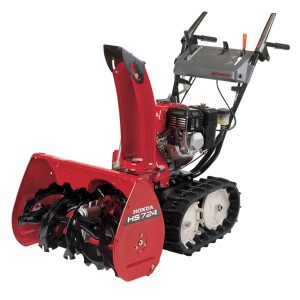 Honda HS724 Troubleshooting Guide Getting the most out of Honda’s HS724 snowblower often means troubleshooting common problems due to simple mistakes or common maintenance issues. Known for their durability and dependability, even Honda’s snowblowers sometimes require a little extra attention to make sure that things like the spark plug, engine oil, and even the starter itself, can continue to function quickly and easily in the aftermath of a major winter storm. When common issues arise, be sure to check some of the most common issues mentioned below to get the equipment back on track.
Honda HS724 Troubleshooting Guide Getting the most out of Honda’s HS724 snowblower often means troubleshooting common problems due to simple mistakes or common maintenance issues. Known for their durability and dependability, even Honda’s snowblowers sometimes require a little extra attention to make sure that things like the spark plug, engine oil, and even the starter itself, can continue to function quickly and easily in the aftermath of a major winter storm. When common issues arise, be sure to check some of the most common issues mentioned below to get the equipment back on track.
Before Troubleshooting, a Quick Safety Disclaimer
Honda’s HS724 snowblower is one of many powerful, two-stage models sold by the company that could result in operator injury if proper safety precautions are not in place. Only troubleshoot the equipment when the engine has had time to cool off, largely to reduce the risk of serious burns or sparks that might ignite engine oil or fuel.
Perform all troubleshooting and required maintenance in an open area and on a flat surface, with proper eye protection and containers for hazardous materials. Remember never to start the equipment in an enclosed area. With these safety guidelines in mind, proceed to the troubleshooting phase to handle any common issue.
What to Check if the Engine Starter is Not Working
The most common reason for the engine starter to fail is an old or damaged power cord that simply isn’t providing power to the mechanism. This can be easily fixed by contacting a local Honda dealer and requesting a replacement OEM starter power cord. Before requesting such a replacement, equipment owners might want to check whether or not the cord works on a different electrical outlet beforehand. Sometimes, low-powered or older outlets can simply fail to supply enough power to the starter for it to function. A secondary outlet may fix this problem without the added expense of a replacement cord.
The Starter is Working, But the Engine Just Won’t Start
Far more complicated than a malfunctioning starter is an engine that doesn’t work even when the starter is fully powered by a good outlet and a new cord. This requires checking several different aspects of the engine itself and the snowblower’s settings, including all of the following:
– Check that the throttle lever is in the proper position.
– Make sure that the fuel valve is not switched to “off.”
– Ensure that the snowblower’s fuel is fresh and ready to go.
– Double-check the spark plug gap to make sure it’s in place and properly sparking the engine’s supply of fuel.
The most common reason for engines to fail even when the starter is functioning normally is simply a problem with the fuel. Whether that means stale fuel is present or the fuel valve isn’t letting any gasoline pass through to the engine will require a bit of extra inspection.
What to Do if the Engine Suffers from Low Power
Even if the engine does turn on, it can sometimes suffer from very low power that makes it very difficult to clear snow after a major winter storm. The first things that should be checked when dealing with a low-powered engine are the freshness of the fuel and the condition of the spark plug. Old fuel will leave the engine struggling to stay on, while an old or damaged spark plug will make it hard for the equipment to enjoy full power.
If these two issues are not to blame, consider checking the auger housing for blockages in the discharge chute. Other worthy considerations include the ground speed of the snowblower, which should always be slower when accumulations are deeper, and the clearing swath, which may need to be narrowed so that the engine can perform as expected.
What to Check if the Engine is Fine but the Snowblower Doesn’t Move
A stationary snowblower is no good after a winter storm, but this problem is one that’s pretty easy to solve. The first thing to check is also the most obvious: Transmission malfunctions or fluid shortages could be causing the snowblower to remain stuck in a neutral, non-moving position. If required, add new transmission fluid and try again.
The shift lever or drive clutch lever could also be experiencing problems. If either one of these levers is not working properly, consider repair or replacement so that the snowblower can move freely. Another thing that might come into play is the drive belt. A damaged or slipped drive belt will easily cause a snowblower to stay put, but this problem can be fixed with a quick repair.
For Maintenance Tools and OEM Replacement Parts, Visit HondaLawnParts.com
HondaLawnParts.com has extensive experience with the Honda brand and ample parts for the HS724 line of snowblowers. With a great online experience that makes it easy to find parts by model number, equipment type, or specific part number, homeowners will find it easy to keep their equipment in top shape.
